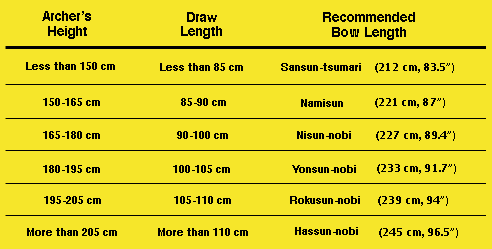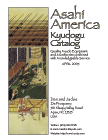Ultimately kyudo must be practiced using natural materials. However, Bamboo bows are delicate and easily damaged by a person inexperienced in Kyudo technique or the care and usage of a Bamboo bow. Bamboo bows carry no warranty or guarantee beyond being insured during shipping. All novice practioners are strongly advised to purchase a Fiberglass or Carbon Fiber bow as a first choice.
But even these may be damaged if used without proper knowledge of Kyudo technique. The Japanese bow is unique in its contsruction and use. It must not be shot using Western archery techniques. We strongly advise that persons interested in Japanese Kyudo first seek out a qualified instructor.
Choosing a TAKE YUMI (Bamboo Bow)
If you plan to purchase a Bamboo Bow please consult first with a qualified Kyudo instructor who is familiar with the care and use of bamboo bows for advice on a bow that is suitable for you. If no instructor is available and/or you live in an area of extreme climate (hot, cold, dry or moist) then a Fiberglass or Carbon Fiber bow is strongly suggested. These synthetic bows are more durable and far more forgiving of improper technique.
It is possible that persons with shoulder or elbow injuries may aggravate the injury by using Fiberglass or Carbon Fiber bows which produce a greater amount of shock at the release. In this case the individual will need to weigh the advantages and disadvantages of the use of a natural or synthetic bow. It is typical in Japan to wait until 3rd or 4th dan is obtained before acquiring a Bamboo Bow; and then only if a qualified instructor is present to assist the student with the care and use of the bow. Do not purchase a Bamboo bow if you do not meet these requirements. Also, as a first choice Bamboo bow a non-Higo yumi (constructed without cross lamination) may be preferable. They are less expensive and sturdier than Higo Yumi.
Bamboo bows are made with either a synthetic bonding agent or with Nibe, a natural bonding agent. Nibe is made by boiling fish air bladder and deer skin for long periods of time. The use of this special glue creates a bow with a smoother draw and release than is possible with a bow constructed with a synthetic bonding agent. However, these high quality Nibe Yumi are constructed during the fall and winter months. And, therefore, one must avoid using a Nibe Yumi in hot, humid conditions because they are susceptible to warping and damage in these circumstances. They are also susceptible to extremely cold or dry weather. Special care and consideration for one’s local environmental conditions must be considered before ordering a Nibe Yumi. When purchasing any Bamboo Bow you must remember that it is unwise to rely on the continual use of a single bow. At least two bows are necessary to allow periods of rest to avoid damage to a Bamboo Bow.
Choosing the correct bow length
It is extremely important to choose the correct length of bow. The bow length is determined by two factors: The archer’s height and Yazuka (arrow length). Experience can also be a factor. Regarding a Bamboo Bow, any individual with less experience and/or having measurements close to the size borderline should consider purchasing the longer length bow.
Below is a chart to help determine the proper size bow.

Choosing the correct pull strength
The correct pull strength is determined by two factors: experience and physical makeup. Ideally, an instructor will start you with a relatively low pull strength (8 to 12 kilograms) and move you up in strength until you are ready to purchase your own bow. If you are unable to do this then a decision will have to be made concerning the proper pull strength for you. As a guide, experienced female archers generally use bows with a 12 to 17 kilogram pull strength while experienced male archers tend to use bows in the 15 to 20 kilogram range. There are two factors to consider when deciding pull strength: If the bow is too strong then it is difficult to learn correct shooting technique. However, if the bow is too weak then you may outgrow it relatively soon.
Care of a Bamboo Bow
A Bamboo Bow should be treated as if it were a living organism. It will be immediately affected by extremes of temperature, humidity and misuse. Its strength may vary according to the season (generally stronger in cold, dry winter months and weaker in the summer). It is not recommended that a Bamboo Bow be used excessively during the course of a day’s shooting. Any use of more than a couple dozen times a day may irreparably weaken the bow. Please respect the bow and be responsible for treating the bow with the care it needs to function well and provide you with years of use. You must limit shooting of a brand new bow to about 15 or 20 arrows a day in the first six months, gradually increasing the number of daily shootings throughout this period. A Bamboo Bow needs to be watched over carefully. It may be left un-strung for short periods of time but leaving it un-strung for extended periods may cause the Urazori (recurve) to become excessive or the shape of the bow to become misaligned. Such conditions may lead to a twisting of the string to the opposite side at the release and cause Kubiore (bow breaks at the Sekiita) or breakage at the Himezori (the curvature below Sekiita). Such damage is self-inflicted and is not under Warranty. An experienced instructor is needed to understand the proper shape of the bow, when and how long to leave the bow strung or un-strung, and the proper stringing of the bow.
Do not leave a Bamboo Bow in an area with high humidity or temperature such as a bathroom or the inside of a car. If the Bow gets wet immediately dry it with a soft cloth. If it is cold, warm it with a soft cloth prior to shooting.
Take care not to scratch or chip the surface area of the Bamboo Bow. The Todake (outer face bamboo) is especially susceptible to Kogai (breaking away of the bamboo) if scratched or chipped.
Stringing the Yumi
Concerning the stringing of the bow, proper tying of the string must be learned to avoid damaging the bow. The upper Tsuruwa (top string loop) should be the same diameter as the Urahazu (The tapered end of the bow that holds the string); too small or too large an opening in the loop will cause the string to slip. Once attached, the tsuru should pass through the center of the Kamisekiita (the part just under the Urahazu). Any bow that curves to the right (the string sits left of center) is called Deki. This is an undesirable condition and requires immediate attention. The bow can be returned to its original position through the use of Kyoseiki (shaping blocks). Likewise, any bow that curves excessively to the left (the string sits too far right of center) is called Iriki and will also require reshaping. A properly designed Bamboo bow will be slightly Iriki in shape. Along with this, the Kyuha (distance from the bow grip to the string) should be maintained to a distance of around 15 cm (this depends on the bow). The Kyuha must be maintained at all times to avoid damage to the bow. If the Urazori (recurve) becomes greater, but the bow is not yet misaligned, the Kyuha may be increased a little (to about 16cm or so) to correct the condition.
* Please note that Asa Tsuru (natural hemp strings) should be used on a Bamboo Bow (especially a Nibe Yumi). Synthetic strings may cause weakness or damage to a Take Yumi. However, Asa Tsuru are more delicate than synthetic strings and, therefore, need care and attention to avoid breakage. Your shooting technique may also affect the longevity of a natural string. If this is the case then use a high quality synthetic string. It is important to always string your bow before changing into your Kyudo uniform. This gives the string time to settle in and adjust to the bow. Stringing the bow twenty minutes prior to shooting is a good rule of thumb.
The Nakajikake (arrow nocking point) should be built up to hold the arrow in place using natural material (hemp or cotton thread).
Never draw and release the bow without an arrow as this can cause serious damage to the bow. Likewise, if the arrow nock slips off the string while in full draw do not attempt to shoot the arrow as this can damage the bow.
As a general rule a Bamboo Bow should be kept un-strung when not in use. However, a new bow may need to have the string attached until it settles in shape. Also, if the Urazori (recurve) becomes too great then the bow should be kept strung. To check the height of the Urazori, place the ends of the unstrung bow on the floor. If the distance between the grip and floor is greater than 20-25cm then the Urazori is too high. An experienced instructor can advise you on this.
Common causes of damage and breakage of a Take Yumi
Storing or using the Bamboo Bow in excessive climatic conditions (extreme heat, cold, moisture and dryness)
Using the bow excessively without periods of rest
Leaving the bow strung or unstrung for long periods which may cause the bow to lose its proper shape
Improper technique that causes the bow to twist counter-clockwise (Hineri) at Hikiwake (draw), Kai (full draw) or Hanare (release) due to an improper Tenouchi (gripping the bow) or excessive strength or torque in the Yunde (left hand)
Releasing the bow without an arrow
Scratching or chipping the bamboo surface
Over-drawing the bow due to improper bow length
Kubiore (breaks at Sekiita) because the string twists upon release due to:
a) an improperly tied or sized Tsuruwa (string loop)
b) the Urazori (recurve) is too high (over 20 cm)
c) the Kyuha (width between grip and string) is too narrow (under 15 cm)
d) the Kyuha (width between grip and string) is too wide (over 20-25 cm)
e) the bow is misshapen
If the TSURU slips while the YUMI is strung and the YUMI happens to twist backwards with the string attached (Hineri) never attempt to re-set the string to the correct position. Instead, cut the TSURU from the YUMI. Attempting to un-twist the string may cause the YUMI to break at the SEKIITA (the weakest part of the YUMI)
Your choice of bow or bow maker may not be available and we may be required to substitute a bow of equal quality by another maker. You will be notified in advance should this be necessary. Our promise is to guide you in selecting the best bow available at the time of purchase.


